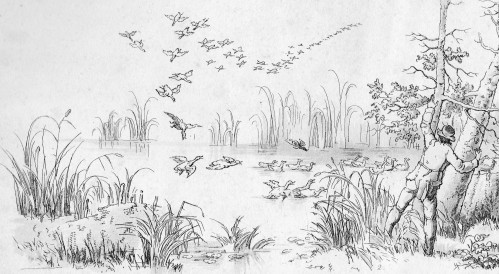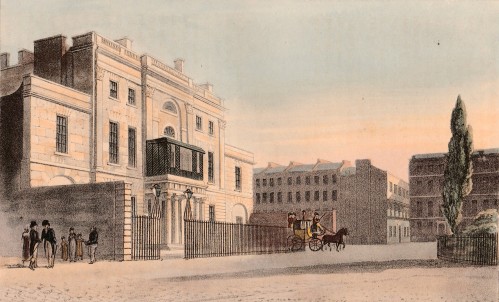Many people will be familiar with the rich and wonderful Wallace Collection of art, objets d’art, furniture and armour in Manchester Square, but I have to admit to never giving the square itself a thought as I visit the collection, let alone that the location of the house might be due to its convenience for duck shooting.

The square was developed between 1776 and 1788 and named for the 4th Duke of Manchester. He had ordered the house on the north side of the square built because of the excellent duck shooting in the area. My immediate reaction was disbelief until I located the position of the square on Roque’s map of 1747. The position is marked in red and all the standing water in the area is coloured in solid blue. These were ponds left by digging clay for brick and tile making and there are far more ponds just beyond the boundaries of the area shown. There was actually a tile kiln just to the south of the square. (The pond above was drawn by W H Pyne and published by Pyne & Nattes in 1804.)

Manchester House itself, now called Hertford House after the 2nd Marquess of Hertford who bought it in 1797, stood on the northern edge of the square and it is the focus of this image published in Ackermann’s Repository in July 1813.

The artist is standing at the entrance to what was Berkley Street (now Fitzharding Street) which leads westwards Portman Square (developed 1764-84) and opposite is the entrance to Hinde Street, leading to Marylebone Lane.
In the Roque map the ancient winding course of Marylebone Lane leads up to the Marylebone Gardens, opened in 1650 and a popular resort. ‘A pretty place,’ according to Samuel Pepys. It was popular for cock fighting, bear baiting, bowling and bare knuckle boxing and it was here that Dick Turpin kissed schoolmaster’s wife Mrs Fountayne, telling her that she now had something to boast about. By 1738 they were enlarged and became much more respectable and famous for their music. They closed in 1778 and the site now lies under Devonshire Street and Beaumont Street.
By the time of Horwood’s map (1799-1818) the entire area was developed and in the section below the only similarities with Roque’s map are the curving lines of Marylebone Lane and the triangular shape of Marylebone burying ground at the top centre. In the period between the two the area of the burying ground was extended south.

Ackermann’s Repository is cool about the remainder of the square: “The other three sides of the square are composed of neat, respectable dwellings, which have nothing of particular notice.”  Certainly, the London Encyclopedia records no interesting inhabitants until the middle of the 19th century, although the staircase of number 20 was the location of the cover shoot for the Beatles’ Please Please Me.
Certainly, the London Encyclopedia records no interesting inhabitants until the middle of the 19th century, although the staircase of number 20 was the location of the cover shoot for the Beatles’ Please Please Me.
The 2nd Marquess of Hertford who bought Manchester House in 1797 had been British Ambassador in Vienna and Berlin and the 3rd Marquess was one of the Prince Regent’s cronies and advised him on the acquisition of works of art, especially Dutch Old Masters and Sèvres porcelain. The 4th Marquess was another collector and connoisseur who lived a reclusive life in Paris and bought up art and furniture that was, post-Revolution, unfashionable. It was this fabulous collection, including works by Watteau, Boucher and Fragonard that he left to his illegitimate son Richard Wallace.
Wallace, knighted in 1871 for his philanthropy, removed the collection from France to Hertford House because of his concerns for the stability of France following the Franco-Prussian war. Following his wife’s death the collection was opened as a national museum in 1900.

